Labs at ITS Engineering College
Labs at ITS Engineering College
The computer centre is well-equipped with computing resources to cater to the academic needs of the students.The center is a constant hub of activities, providing a conducive learning environment.
The trained technical staff is available to help the students.
Wi-Fi Facilities at ITS
To keep pace with the fast-changing World & to make the World a smaller place to live in, ITS provides fast Internet facility in its campus. The institute also has access to the Internet through a WI-FI for the students and staff. The Internet facility is available throughout the campus. A highly specialized state-of the-art Internet lab is there for students to access the net whenever they wish to do so.
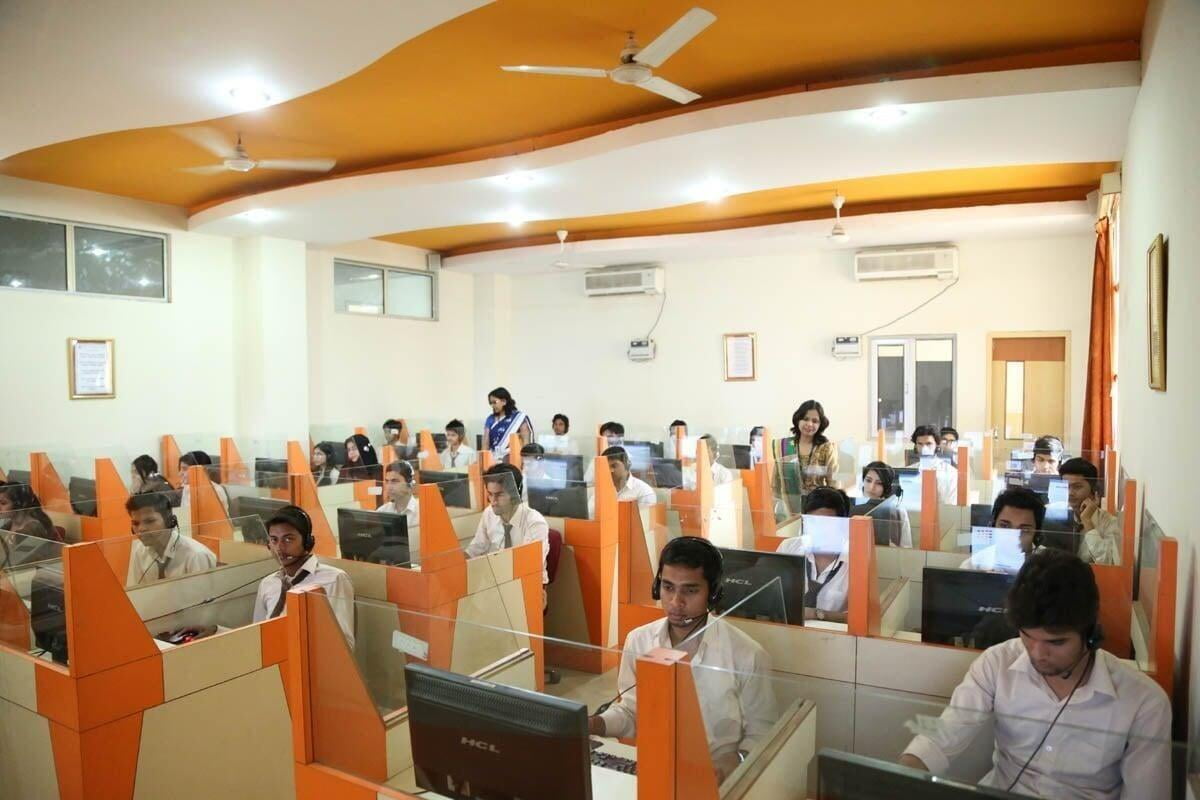
Communication Lab
The lab attempts to inculcate the practical skills of communication which include discussion session, presentation, mock meetings mock interview with an objective of developing the all-round personality, particularly the qualities of leadership, dynamism, team building positive value-based attitude and confidence among the scholars.
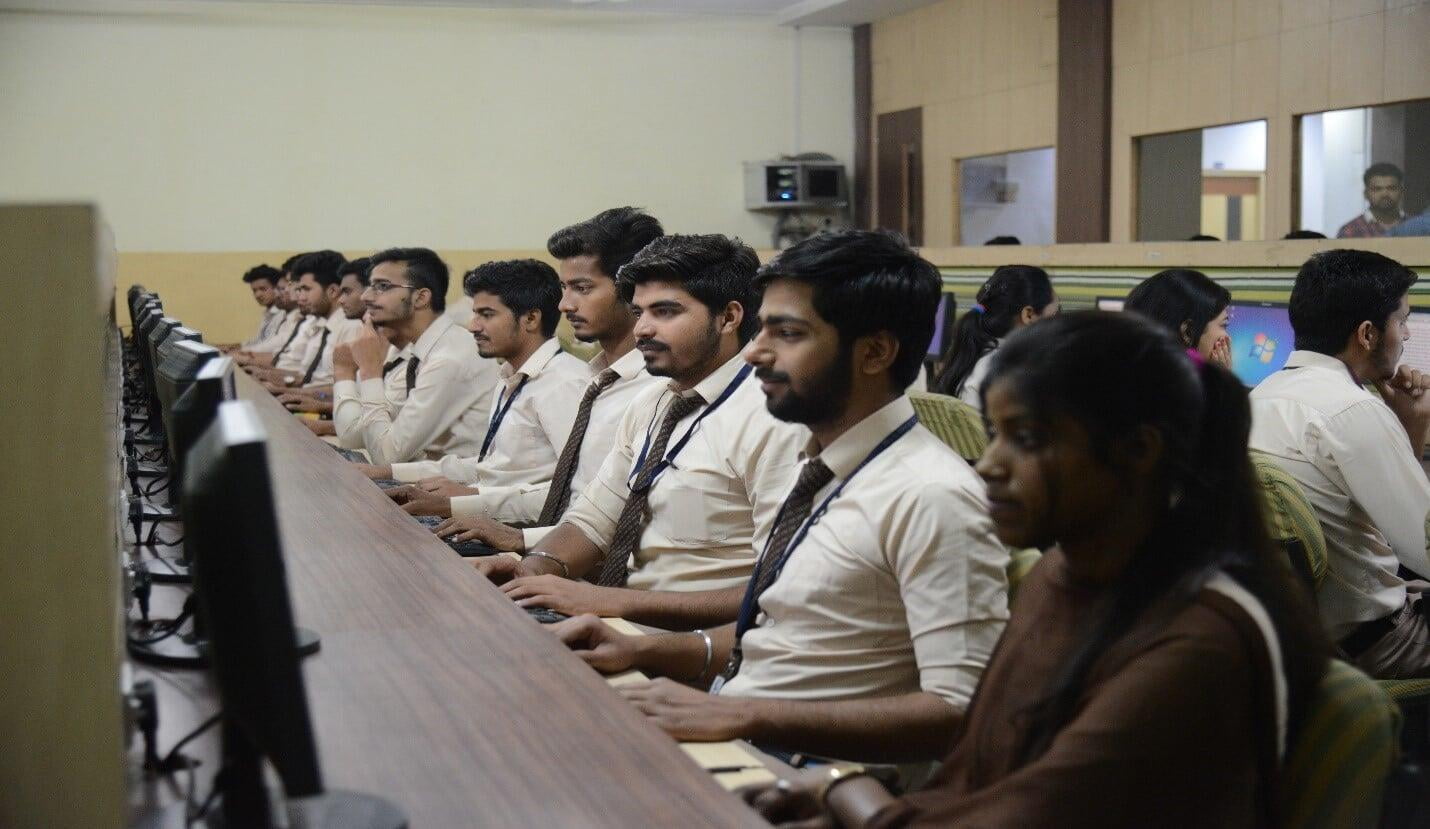
Operating System Lab
This lab is meant to boost the implementation level knowledge of operating system and provide the student thorough knowledge of algorithm and memory management.
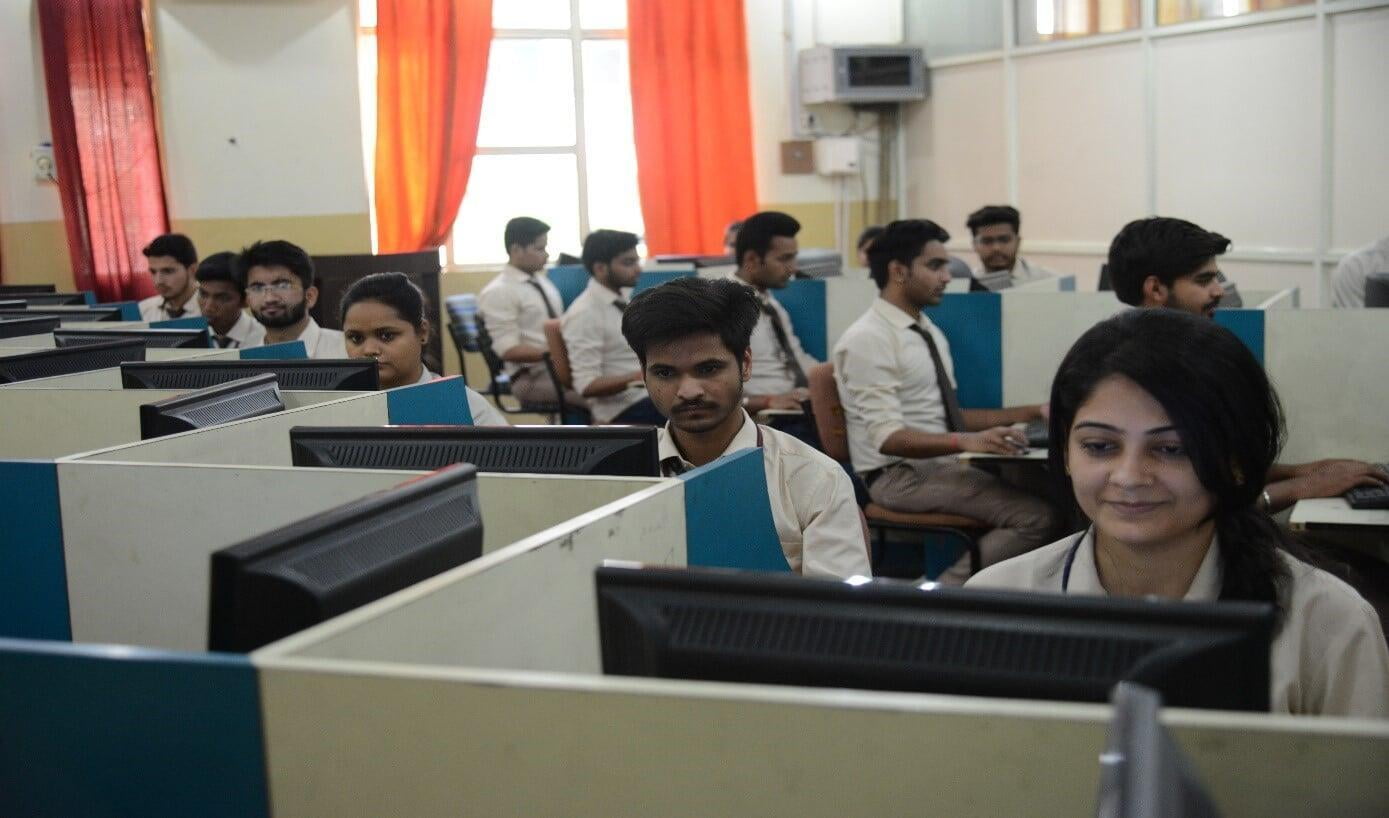
Web Technology Lab
The objective of this lab is to become familiar with the concepts of web,internet,networks,creation of websites through html,java script
\
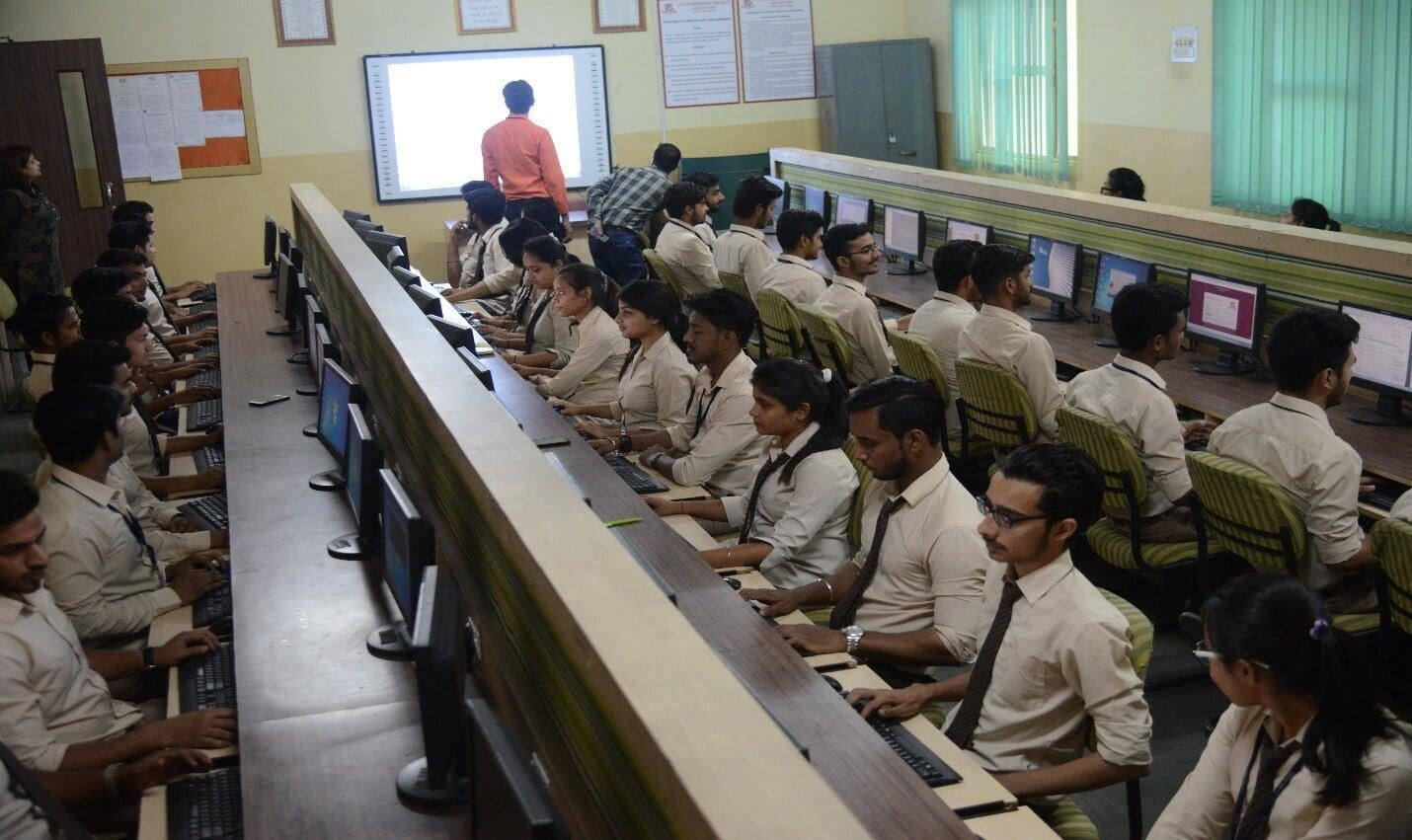
Python Lab
The objective of this lab is to become familiar with the Python IDE for version 3.X while introducing basic mathematical operations, variable types, and printing option
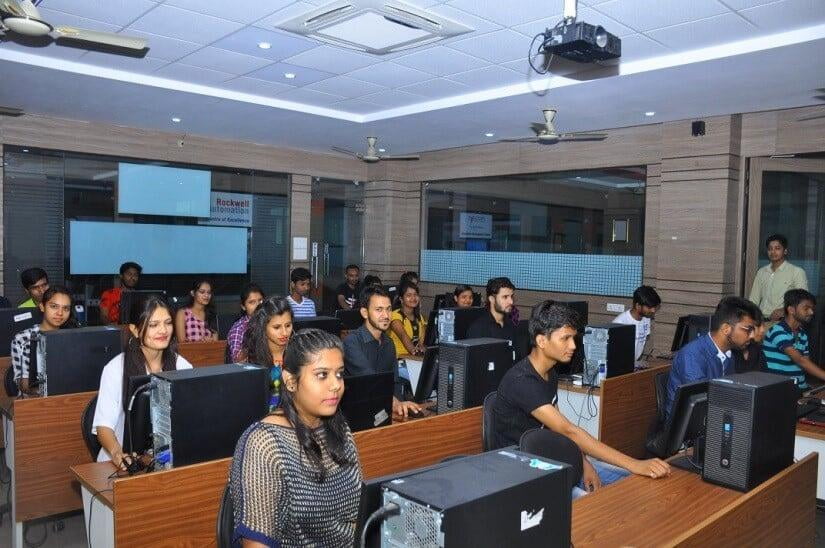
System Softwares
•Windows 10
•Windows 2003 Server
• Windows 2008 Server
•Windows 2012 Server
•Windows 2016 Server
•Red hat Linux
Application Softwares
•Ms Office 2003 std.
•Ms Office 2007 std
•Ms Office 2010 std.
•Office 365
•Turbo C++
•Codegear C++ Builder
•Ms Exchange Server 2007
•IBM Rational Rose
•Oracle 10g Std
•Quick Heal Antivirus(Console Based)
•Microsoft Dream Spark(MSDN AA)
•ORCAD
•MAT Lab
•VHDL
•Lab View
•Auto Desk Inventer 9
•ProE
•Renet Digital Multi Media
•Clearity Software Pack
•Tense Buster
•Study Skill Success
•Sky Pronunciation
•Business Writing
•Error Terror
•Author plus Pro
Data Structure Lab
Quick Stats:-
- The objective of this course is to implement various algorithms based on the concept of Data Structures.
Contents:-
- Addition and multiplication of two 2D arrays
- Array implementation of stacks.
- Array implementation of Queues.
- Array implementation of Circular Queues. Array implementation of Circular Queues.
- Creation of Linked ListCreation of Linked List
- Insertion, Deletion and Display of Linked List
- Implementation of stack using linked list
- Implementation of queue using linked list
- Implementation of Searching Algorithms: Linear and Binary Search
- Implementation of Sorting Algorithms: Insertion, Selection, Quick, and Merge Sort
Digital Logic Design Lab
Quick Stats:
- The objective of this course is to learn the students to implement various LOGIC CIRCUIT flip flop,Counters, and their experimental approach.
Content:
- Introduction to digital electronics lab- nomenclature of digital ICs, specifications, study of the data sheet, Concept of Vcc and ground, verification of the truth tables of logic gates using TTL ICs.
Discrete Structure & Logic Lab
Quick Stats:-
- This lab is meant to work with concepts from discrete structures. Discrete structures lab include topics such as set theory, logic, graph theory, and probability theory.
- Demonstrate mathematical skills, analytical and critical thinking abilities.
- Recreates classroom learning experience with hands-on practical on Discrete Structure .
- Contents:- To understand the Working of Computation software.
- To Discover a closed formula for a given recursive sequence vice-versa.
- To implement Recursion and Induction: Practice of proof techniques.
- Testing of set operating using software
- To implement Combinatorial equivalence.
- To implement Permutations and combinations.
- Implementation of a recursive counting technique.
- To implement N digit binary sequences not having adjacent 1’s.
- To implement Binary relations.
Computer Organization Lab
Quick Stats:
- The objective of this course is to teach the students to appreciate digital logic specification methods and the compilation process that transforms these into logic networks.
Content:
- Implementing HALF ADDER, FULL ADDER using basic logic gates.
- Implementing Binary -to -Gray, Gray -to -Binary code conversions.
- Implementing 3-8 line DECODER and Implementing 4x1 and 8x1 MULTIPLEXERS.
- Verify the excitation tables of various FLIP-FLOPS.
- Design of an 8-bit Input/ Output system with four 8-bit Internal Registers.
- Design of an 8-bit ARITHMETIC LOGIC UNIT.
- Design the data path of a computer from its register transfer language description.
- Design the control unit of a computer using either hardwiring or microprogramming based on its register transfer language description.
- Write an algorithm and program to perform matrix multiplication of two n * n matrices on the 2-D mesh SIMD model, Hypercube SIMD Model or multiprocessor system.
- Study of Scalability for Single board Multi-board, multi-core, multiprocessor using Simulato
Operating System Lab
Quick Stats:-
- This lab is meant to boost the implementation level knowledge of operating system and provide the student thorough knowledge of algorithm and memory management.
- Highly practical program for effective learning of Operating System.
- Recreates classroom learning experience with hands-on practical on Operating System.
Contents:
- To implement CPU Scheduling Algorithm: FCFS
- To implement CPU Scheduling Algorithm: SJF
- To implement CPU Scheduling Algorithm: PRIORITY
- To implement CPU Scheduling Algorithm: ROUND ROBIN
- To implement Banker’s Algorithm for deadlock avoidance.
- Simulate Page Replacement Algorithm: FIFO
- Simulate Page Replacement Algorithm: LRU
- Simulate Page Replacement Algorithm: Optimal
- Simulate Paging Technique of Memory Management
Theory of Automata & Formal Language
Quick Stats:-
- This lab is meant to boost the implementation level knowledge of Automata theory by practical approach and provide the student to create the concept of automata theory in Lab.
- Highly practical program for effective learning of Automata.
- Recreates classroom learning experience with hands-on practical on JFLAP Software.
Contents:-
- To Design & Simulate Deterministic Finite Automata (DFA) & Nondeterministic Finite Automata (NFA) Using JFLAP
- To Design & Simulate the Conversion of NFA to DFA Using JFLAP.
- To Design & Simulate Minimization of Deterministic Finite Automata (DFA) Using JFLAP.
- To Design & Simulate Mealy and Moore Machine Using JFLAP.
- To Design & Simulate DFA to Regular Grammar Conversion & DFA to Regular expression Conversion Using JFLAP.
- To Design & Simulate Pushdown Automata Using JFLAP.
- To Design & Simulate Single Tape & Multi-Tape Turing Machine Using JFLAP.
- To Design & Simulate Context free grammars (CFG) with single symbol & multiple symbols Using JFLAP.
- To Design & Simulate LL Parsing & LR Parsing Using JFLAP.
- To Design & Simulate Regular pumping lemma & Context free pumping lemma Using JFLAP.
Computer Graphics Lab
- Quick Stats:-
- This lab is meant for the basic implementation knowledge of Graphics Algorithm and provide student with thorough knowledge of Geometric transformations.
- ·Programs for effective learning of Standardised Line and Circle drawing Algorithms.
- ·Recreates classroom learning experience with hands-on practical on Geometric transformations.
Contents:-
- To implement basic inbuilt graphic functions.
- To implement DDA Algorithm.
- To implement BRESENHAM LINE Drawing Algorithm.
- To implement BRESENHAM CIRCLE Drawing Algorithm.
- To implement 2D TRANSLATION.
- To implement 2D ROTATION.
- To implementation of 2D SCALING.
- To implement 3D TRANSLATION.
- To implement 3D ROTATION.
- To implement 3D SCALING.
- To implement COHEN SUTHERLAND LINE CLIPPING Algorithm.
- To implement LIANG BARSKY LINE CLIPPING Algorithm.
• Central Workshop
• Manufacturing Science Lab
• Engineering Mechanics Lab
• Material science and testing Lab
• Machine Design Lab
• Thermodynamics Lab
• Fluid Mechanics Lab
• Metrology and Measurement Lab
• Theory of Machines Lab
• Refrigeration and Air-conditioning Lab
• Fluid Machinery Lab
• Heat and Mass Transfer Lab
• CAD/CAM Lab
• I.C. Engine & Automobile Engg. Lab

Fluid Mechanics Lab
Quick Stats:-
Determination of fluid forces and behavior during the fluid flow over a solid object
Content:-
· Momentum equation using the experimental set-up on impact of jet.
· Meta-centric height of a given ship model.
· Coefficient of discharge of an orifice
· Coefficient of discharge of Venturimeter
· Verification Bernoulli’s Principal
· Discharge over notches
· Darcy’s Law
· Head loss for a sudden enlargement.
· Losses due to pipe fitting.
Course Outcome:
CO1: Knowledge to design piping system and its components.
CO2: Ability to evaluate and compare different flow meters.
CO3: Understanding to predict losses in various fluid dynamical systems.
CO4: Acquire the knowledge to explain the role of pressure as a driving force.
CO5: Able to demonstrate the calibration of flow meters
Heat And Mass Transfer Lab
Quick Stats:-
Subjects commonly applied in renewable energy, industrial, commercial and domestic systems. The laboratory consists of experiments on various conductive, convective, radiative mechanisms of heat transfer.
Content:-
· Conduction – Heat conduction through lagged pipe
· Conduction – Experiment on Composite plane wall
· Conduction – Experiment on Thermal Contact Resistance
· Convection - Experiment on heat transfer from vertical tube
· Convection- Heat flow through forced convection
· Convection - Heat transfer through fin
· Radiation- Experiment on Stefan's Law with apparatus.
· Radiation- Experiment on determination of emissivity
· Heat exchanger - Parallel flow experiment
· Heat exchanger - Counter flow experiment
Course outcomes:-
CO1: Knowledge to find the rate of heat flow through conduction
CO2: Ability to find the local and average convective heat transfer coefficient
CO3: Understanding of determining the rate of heat flow through convection and radiation
CO4: Understanding of the performance evaluation of heat exchange
CAD/CAM Lab
Quick Stats:-
This course is the integration of Computer-Aided-Design (CAD) and Computer-Aided-Manufacturing (CAM). It involves the study of modern prototyping and machining methods, teaching the use of specific software for converting 2D and 3D CAD drawing geometry directly into tool path information used to drive numerically controlled turning and milling
Content:-
· Writing and validation of computer Program for line and c Geometric Transformation algorithm for translation/rotation/scaling: Writing and validation of computer program.
· Understanding and use of any 3-D Modeling Software
· Writing and validation of computer program for Root findings or curve fitting
· Solid modeling of a machine component using Solidworks
· Characteristic features of CNC machine
· Part Programming on CNC machine for turning and milling operation
Course outcomes:-
CO1:Develop the understanding of basic line drawing algorithm and circle drawing algorithm for Raster Scan screen.
CO2: Understanding of transformation algorithm (translation/rotation/scaling/ shearing/ mirror)
CO3: Acquire the fundamentals of 3-D modeling software.
CO4: Learn the specified parameters required to perform the various machining operations on cnc .
Manufacturing Technology Lab
Quick Stats: -
Scientific principles governing conventional machining processes
Contents:-
· Bolt (thread) making on Lathe machine
· Tool grinding on tool-grinder machine.
· Gear cutting on Milling machine.
· Machining a block on Shaper machine.
· Finishing of a surface on surface-grinding machine.
· Drilling holes on drilling machine and study of twist-drill.
· Study of different types of tools and its angles & materials.
· Gas welding experiment
· Arc welding experiment
· Resistance welding experiment.
Course Outcome:
CO1: Knowledge of various types of machine tools and cutting tools.
CO 2: Able to understand various types of materials used in manufacturing of cutting tools.
CO 3: Able to understand various machining operations.
CO 4: Able to understand the effect of machining parameters on the surface finish and metal removal rate.
CO 5: Understanding of the various welding processes including parameters and selection
IC Engine And Automobile Engineering Lab
Quick Stats: -
The course helps to understand the fundamentals of how the design and operation of internal combustion engines affect their performance, operation, fuel requirements, and environmental impact.
Contents:-
· Breaking System
· Fuel Supply System
· Ignition System
· Steering System
· Transmission System
· Suspension System
· Lighting System
· Lubrication System
Course outcomes:-
CO1: Able to demonstrate the working process of transmission system in automobile.
CO2: Able to demonstrate the working principle of lubrication system in IC engines.
CO3: Able to demonstrate the working of fuel injection and fuel ignition system in IC engine.
CO4: Able to demonstrate the working principle of differential gear box.
CO5:Able to demonstrate the working principle of hydraulic brake system.
CO6: Able to demonstrate the working principle of steering mechanism.
CO7: Able to demonstrate the working principle of cooling and lubrication methods.
A Special feature of the department is its fully equipped laboratory with the latest state-of-the-art equipment, apparatus, and software. Students are encouraged to do electronic projects of their choice under the guidance of experienced faculty. The students work in following laboratories:
• Electronics Workshop and PCB Lab
• CAD Lab
• Digital Lab
• Microprocessor Lab
• Communication Lab
• Analog Integrated Circuit Lab
•TI Analog Integrated Circuit Lab
• Digital Signal Processing Lab
• Microcontroller Lab
• Microwave and Optical Communication Lab
•TI Embedded lab
• Project Lab
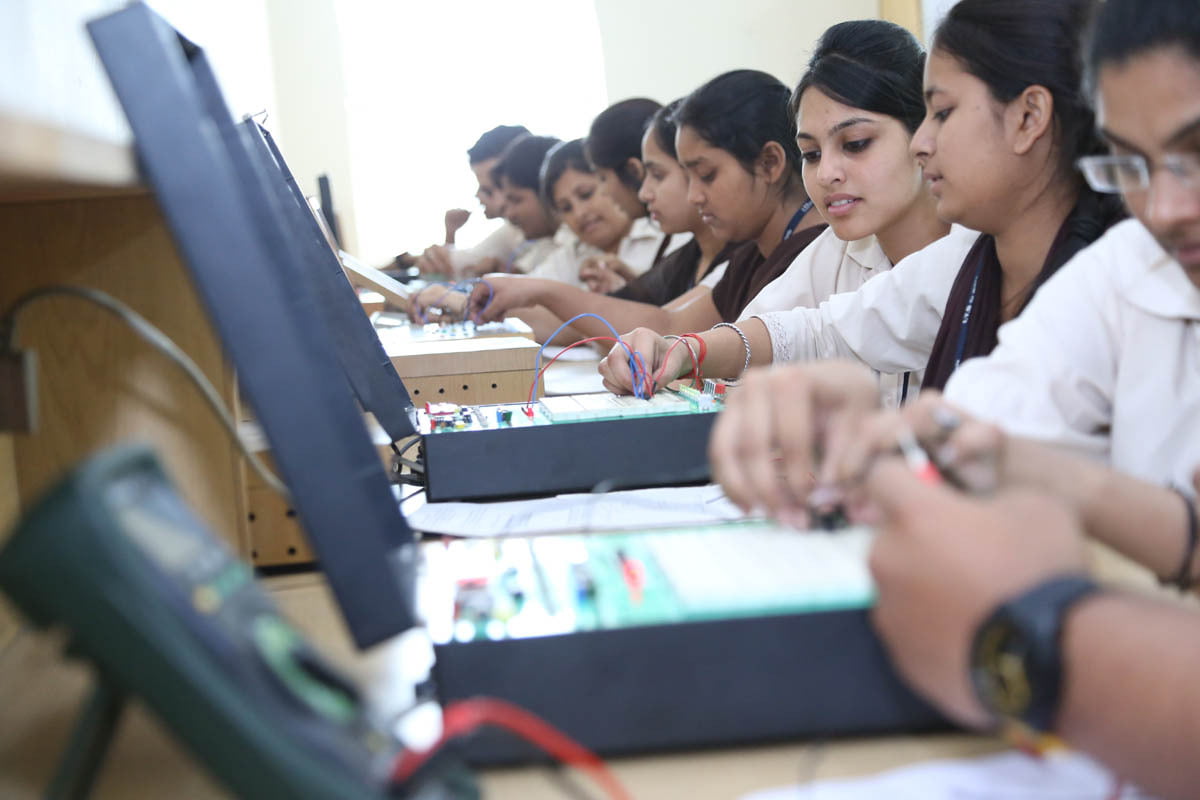
Network Analysis & Synthesis Lab
Quick Stats:-
To make the students capable of analyzing any given electrical network and how to synthesize an electrical network from a given impedance/admittance function.
Contents:-
· Study and verification of network theorems with input signal of 1 kHz, 10kHz and 100kHz.
· Verification of two port network parameters.
· Step and Ramp response of series and parallel RC circuits.
· Verification of properties of RC circuits.
· Verification of properties of RL circuits.
· Verification of properties of LC circuits.
· Verification of inverting, non-inverting and voltage follower VCVS circuits using 741 op-amp.
· Verification of inverting integrator using 741 op-amp.
· Design a finite gain differential amplifier with infinite input impedance and verify the output response.
Course Outcomes:-
CO-1 Able to apply the fundamental concepts in solving and analyzing different Electrical networks.
CO-2 Able to Select appropriate and relevant technique for solving the Electrical network in different conditions.
CO-3 Able to apply mathematics in analyzing and synthesizing the networks in time and frequency domain.
CO-4 Able to Estimate the performance of a particular network from its analysis.
CO-5 Able to understand operational Amplifiers with different network.
Electronics Workshop and PCB Lab
Quick Stats:-
To understand Hardware Technology
Contents:-
· Study of CRO, DMM, Function Generator
· Active and Passive Components
· Transformer Winding
· Masking
· Development of Negative
· Development of PCB
· Etching
· Drilling of PCB
· Soldering of components
· Testing of Circuit
Course Outcomes:-
CO-1. Able to understand active, passive component and use of DMM, CRO.
CO-2. Able to analyze the fabrication processes of printed circuit boards.
CO-3. Perform the chemical and mechanical processes by using negative/positive masks
CO-4. Students are able to define how to operate the hardware (i.e. drilling, etching, milling equipments as well as the developer and etcher machines)
Logic Design Lab
Quick Stats:-
To understand the digital logic and create various systems by using these logics
Contents:-
· Nomenclature of digital IC’s, Concept of Vcc and ground
· Verification of truth table of the of logic gates
· Implementation of Boolean function
· Verification of state tables of various flip-flop.
· Implementation and verification of Decoder/De-multiplexer and Encoder
· Implementation of multiplexer
· Implementation of 4-bit parallel adder
· Design, and verification 4-bit synchronous counter.
· Design, and verification of 4-bit asynchronous counter.
Course Outcomes:-
CO-1. Able to understand the basic theory of Boolean algebra & the underlying features of various number systems.
CO-2. Able to use the concepts of Boolean algebra for the analysis & design of various combinational & sequential logic circuits.
CO-3. Able to design various logic gates starting from simple ordinary gates to complex programmable logic devices & arrays.
CO-4. Able to understand sequential logic circuits design both in synchronous and Asynchronous modes, their minimization techniques and their realizations.
Integrated Circuit Lab
Quick Stats: - To design and implement the circuits to gain knowledge on performance of the circuit and its application. These circuits should also be simulated on PSPICE and implemented using TL082, LM741, NE555, ASLK, MPY634 XP, connecting wires, power supply, function generator and oscilloscope.
Content:-
· Design unity gain amplifier, non-inverting amplifier, an inverting amplifier & Log and antilog amplifiers.
· Design and teat an AGC system for a given peak amplitude of sine-wave output.
· Design second order Low pass, High Pass & band pass filters of specified cut off frequency.
· Wien bridge oscillator using operational amplifier.
· Design and test a PLL to get locked to a given frequency ‘f’.
· Design and test the integrator for a given time constant.
· Voltage to current and current to voltage convertors.
· Design and Test a function generator that can generate square wave and triangular wave output for a given frequency
· Astable and Monostable Multivibrator using 555 IC.
· Design and test a low drop out regulator using op-amps for a given voltage regulation characteristic and compare the characteristic with TPS7250IC.
Communication Lab
Quick stats:
Communication lab is closely associated with all type of analog data transmission techniques. Provide basics of various antenna systems with its radiation parameters.
Content:-
· DSB/ SSB amplitude modulation & determine its modulation factor & power in side bands.
· Amplitude demodulation by linear diode detector.
· PLL 565 as frequency demodulator.
· Sampling and reconstruction of Pulse Amplitude modulation system.
· Sensitivity, Selectivity, and Fidelity characteristics of super heterodyne receiver.
· Pulse Amplitude Modulation by using switching method & by sample and hold circuit.
· Pulse Width Modulation and Pulse Position Modulation.
· Plot the radiation pattern of a Dipole, Yagi-uda and calculate its beam width.
· Plot the radiation pattern of Horn, Parabolic & helical antenna.
· Amplitude modulation/Demodulation using Virtual Lab Software.
· Frequency modulation and determine its modulation factor using Virtual Lab Software.
The department is proud to possess the following labs for B. Tech EEE course. All laboratories are being regularly upgraded and new labs with latest software MATLAB and LabVIEW are added according to the curriculum requirement of the University.
•Electrical Engineering Lab
•Electrical Engineering Lab
•Electrical Network Lab
•Electrical Measurement Lab
•Electrical Machines Lab
• Power Electronics and Drives Lab
• Control system Lab
• Electrical CAD Lab
• Power System Lab
• Electrical Instrumentation Lab
•Simulation Lab
• Project Lab
• PLC/SCADA Lab (Rockwell)
Control System Lab
Quick states:
Control System Lab provides students with hands-on experience with performance analysis of control system under different transient conditions, stability analysis of control system by using different techniques of stability analysis, speed control of AC servomotor, single phase universal motor and DC/AC motor by using open loop and closed loop control systems, etc.
Content
- To study P, PI, PID temperature controller for an oven and compare their performance.
- To determine speed torque characteristics of an ac servomotor.
- To study speed control of a single phase universal motor by using a TRIAC
- To study DC/AC motor speed control system on open loop and closed loop system.
- To study the open loop response and closed loop transient response on compensator.
- To study the open loop response and closed system response on linear system simulator.
- To determine time domain response of a second order system for step input and obtains performance parameters.
- To convert transfer function of a system into state space form and vice-versa.
- To plot root locus diagram of an open loop transfer function and determine range of gain `k` for stability.
- To plot a Bode diagram of an open loop transfer function.
- To draw a Nyquist plot of an open loop transfer functions and examines the stability of the closed loop system
- Provide practical hands-on experience with control system applications.
- Understand the concept of system stability.
- Understand the concept of controlling the various parameters in an industry
Power System Lab
Quick States :
Power electronics is based on fast-switching high efficiency silicon power semiconductor devices. Power Electronics Lab enables the students to have hands on practice in the following field of Electrical Engineering: Power semiconductor devices, such as diode, thyristor, triac, GTO, power MOSFET, IGBT and IGCT, DC and AC regulated power supplies, Heating and lighting control, Power line static VAR compensators, Flexible ac transmission (FACT) systems, HVDC systems, Photovoltaic (PV) and fuel cell (FC) converters, DC and AC circuit breakers, high frequency heating and energy storage, DC and AC motor drives.
Content :
- To study V-I characteristics of SCR and measure latching and holding currents
- To study single phase (i) fully controlled (ii) half controlled bridge rectifiers with resistive and inductive loads.
- To study three-phase fully/half controlled bridge rectifier with resistive and inductive loads.
- To study single-phase ac voltage regulator with resistive and inductive loads.
- To study single phase cyclo-converter.
- To obtain simulation of SCR and GTO thyristor.
- To obtain simulation of Power Transistor and IGBT.
- To obtain simulation of single phase fully controlled bridge rectifier and draw load voltage and load current waveform for inductive load.
- To study MOSFET/IGBT based single-phase series-resonant inverter.
- To study MOSFET/IGBT based single-phase bridge inverter.
· Course Outcomes
- Will be able to determine fault current for L-G, L-L, L-L-G and L-L-L faults at the terminals of an alternator at very low excitation
- Will be able to study the IDMT over current relay and determine the time current characteristics
- Will be able to study the IDMT under voltage protection relay and determine the time voltage characteristics
- Will be able to study the IDMT over voltage protection relay and determine the time voltage characteristics
- Will be able to study Earth fault protection relay
- Will be able to determine location of fault in a cable using cable fault locator
- Will be able to study Ferranti effect and voltage distribution in H.V. long transmission line using transmission line model.
Electrical Measurement & Measuring Instruments Lab
Quick states :
Entrepreneurship and Innovation is not just about start-ups: it is a topic that is rapidly growing in importance in government policy and in the behaviour of established firms. The course provides students with an understanding of the role and personality of the entrepreneur, and a range of skills aimed at successful planning of entrepreneurial ventures. Material covered includes fostering creativity and open-mindedness, knowledge acquisition and management, innovation systems, screening and evaluating new venture concepts, market evaluation and developing a marketing plan, legal Issues Including intellectual property, preparation of venture budgets, and raising finance. The major piece of assessment is the writing of a comprehensive business plan for a new venture
Content :
- Entrepreneurship- definition. growth of small scale industries in developing countries role , characteristics of small scale industries in the national economy;. Government policy for small scale industry; stages in starting a small scale industry.
- Project identification- assessment of viability, formulation, evaluation, financing, field-study and collection of information,
- Accountancy, Preparation of balance sheets and assessment of economic viability,
- Project Planning and control: The financial functions, cost of capital approach in project planning and control. Economic evaluation, risk analysis, capital expenditures, policies and practices in public enterprises..
- Laws concerning entrepreneur viz, partnership laws, business ownership, sales and income taxes and workman compensation act
Course Outcome:
The aims of this course are:
- To develop an understanding of business innovation and the roles of entrepreneurs
- To develop skills in innovation and business planning for entrepreneurial ventures
- To increase students’ ability to work in multidisciplinary teams and to provide entrepreneurial leadership in organisations.
- To understand entrepreneurship and business innovation, the evolution of industries and economies and the roles of entrepreneurs
- Develop a comprehensive and well structured business plan for a new venture
- Work effectively in multidisciplinary, cross-cultural teams, communicating, negotiating and contributing shared inputs towards the development of a team project
- Entrepreneurship Development Programme (EDP) means a programme conducted to help a person in strengthening his entrepreneurial motive and in acquiring skill and capabilities required for running an enterprise.
- The course contents of EDPs generally consists of six inputs namely, general introduction to entrepreneurship, achievement motivation training, support system and procedures, market survey and plant visit, managerial skill, project preparation and feasibility study.
Simulation Lab
Solution of differential equation using 4th order runge - kutta method
*Determination of time response of an RLC circuit
* Single line Modeling of DC motor
* Step, Ramp and impulse response of transfer function
*Generation of single and three phase sinusoidal waveform
*PWM based waveform generation
*Single phase uncontrolled half wave rectifier using R and RL load
*Single phase and three phase uncontrolled full wave rectifier using R and RL load
·
Course Outcome
- Able to develop programs on MATLAB
- Ability to model and analyze different mathematical applications .
- Ability to understand and analyze engineering problem
Basic Electrical Engineering Laboratory
Quick Stats:
Better understanding of Basic Electrical Engineering Principles, theorems and electrical machines.
Contents:
- Various symbols of electrical equipments and machines.
- Use of multimeter, tachometer and breadboard.
- Verification of various theorems on tailor made circuits.
- Electrical measuring instruments.
- Performance of DC motor, three phase induction motor and single phase induction motor.
- Course Outcome
CO-1To understand the basic terminology used in electrical engineering.
CO-2. To make various circuits.
CO-3. To analyze different circuits by using different theorems.
CO-4. To analyze the performance of single phase transformer.
CO-5. To calculate the efficiency of dc shunt motor.
CO-6. To reversing and running of three phase induction motor.
CO-7. To calculate the parameters of series R-L-C circuits and resonance frequency.
CO-8. To improve power factor of single phase circuits and also measure three phase and single phase power.
Electrical Design & Fabrication Lab
Quick states :
Electrical Design & Fabrication Lab provides students with hands-on experience with designing and fabrication of electrical and electronics circuits used in routine engineering applications. The aim of this lab is to introduce PCB technology along with transformer and supply design. Designing and fabrication various filters, controller, amplifiers, rectifiers which are frequently used in all EEE circuits are also to be introduced.
Content :
- PCB Design & Fabrication.
- Transformer design & Fabrication.
- Small Power Supply design & Fabrication.
- Filter design & Fabrication.
- Controller design & Fabrication.
- Inductor design and Fabrication.
- Measurement of electrical parameters of AC & DC machine.
- Design & Fabrication of High Power factor controlled rectifier.
- Design & Fabrication of Microcontroller based digital energy meters / sensors.
- Design & Fabrication of Power amplifier.
- Design Fabrication of AC phase converter and its firing circuit.
- IGBT based single phase inverter design and Fabrication.
- Design & Fabrication of chopper.
Network Lab
Quick states :
Basic understanding of various network theorems, transient response RL,RC and RLC network, Frequency network, two port networks and parameters
· Content :
Verification of principle of superposition with ac sources.
2. Verification of Thevenin, Norton and Maximum power transfer theorems in ac circuits.
3. Verification of Tellegin’s theorem for two networks of the same topology.
4. Transient response of current in RL and RC circuits with step voltage input.
5. Determination of transient response of current in RLC circuit with step voltage input for underdamp, critically damp and overdamp cases.
6. Determination of frequency response of current in RLC circuit with sinusoidal ac input.
7. Determination of z and h parameters (dc only) for a network and computation of Y and ABCD Parameters.
8. Determination of driving point and transfer functions of a two port ladder network and verify with theoretical values.
9. Determination of image impedance and characteristic impedance of T and Π networks, using O.C. and S.C. tests.
Course Outcomes:
CO1: Will be able to verify principle of superposition with ac sources.
CO2: Will be able to verify Thevenin, Norton and Maximum power transfer theorems in ac circuits.
CO3: Will be able to verify Tellegin’s theorem for two networks of the same topology.
CO4:Will be able to determine transient response of current in RL and RC circuits with step voltage input.
CO5:Will be able to determine transient response of current in RLC circuit with step voltage input for underdamp,
CO6:Will be able to determine frequency response of current in RLC circuit with sinusoidal ac input.
CO7:Will be able to determine z and h parameters (dc only) for a network and computation of Y and ABCD Parameters.
CO8 : Will be able to determine driving point and transfer functions of a two port ladder network and verify with theoretical values.
Electric Workshop
Quick states :
- To study the working principle and wiring of fluorescent lamp.
- To study and wiring of distribution board including power plug using isolator, MCB,ELCB.
- To study and estimate a typical, BHK house wiring.
- Familiarization, soldering, testing and observing the wave forms on CRO of a HW and FW uncontrolled rectifier (using diodes) with capacitor filter.
- Visit your college substation and familiarize the supply system, Transformer, HT Paneland Distribution etc.
- To study construction, working and application of workshop tools. Also study the Electrical and Electronics Symbols.
- To study the wires, cables and their gauges, Domestic Electrical Accessories.
- Mini Project on PCB.
- To study fault, Remedies in Domestic Installation and Indian Electricity Rules.
- To study the different types of earthing system and measure the earth resistance.
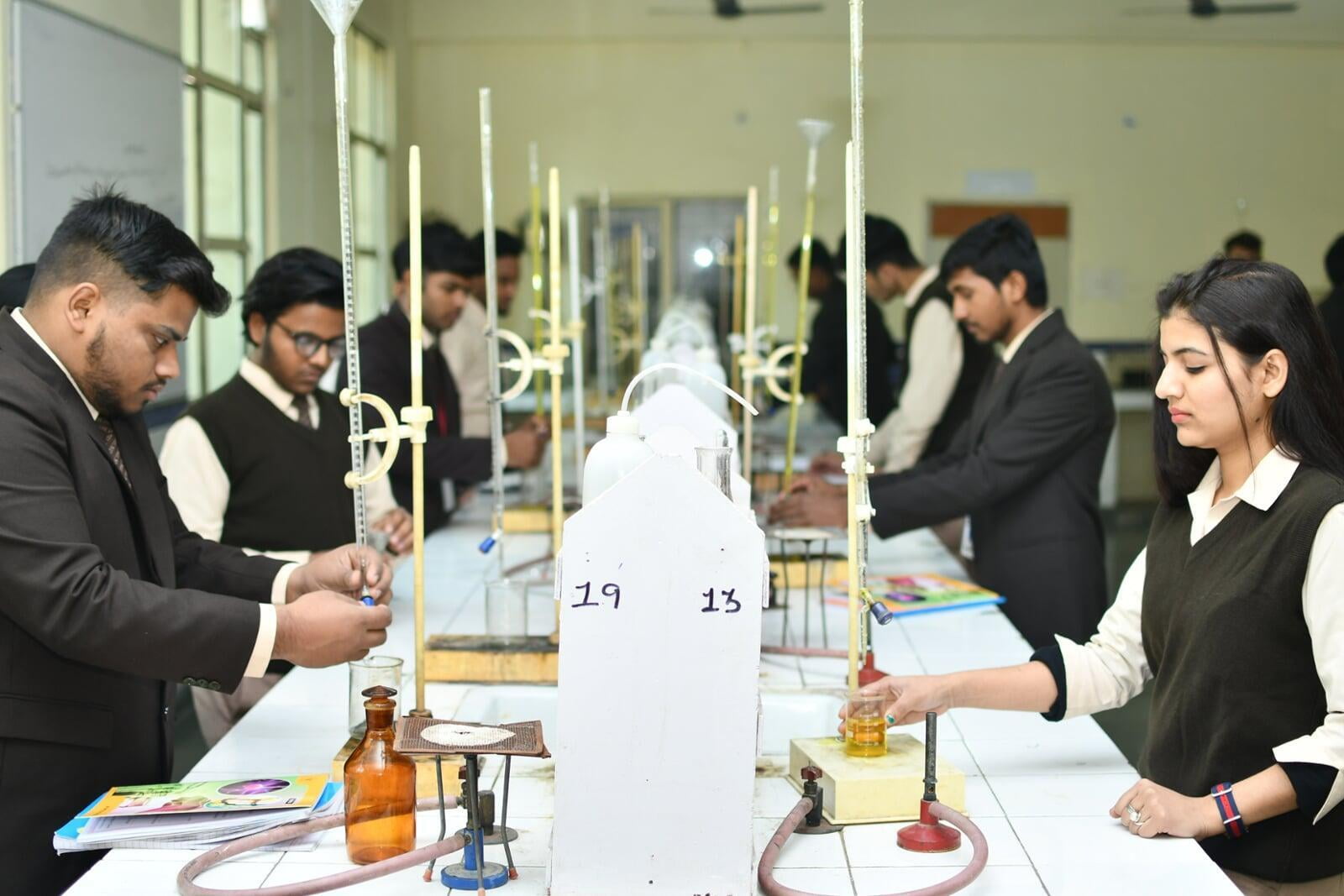
It provides students with a practical approach towards the various techniques used in engineering application. Practical awareness is inculcated and students are trained both quantitatively and qualitatively during the lab sessions so that their understanding and problem solving abilities can be enhanced.
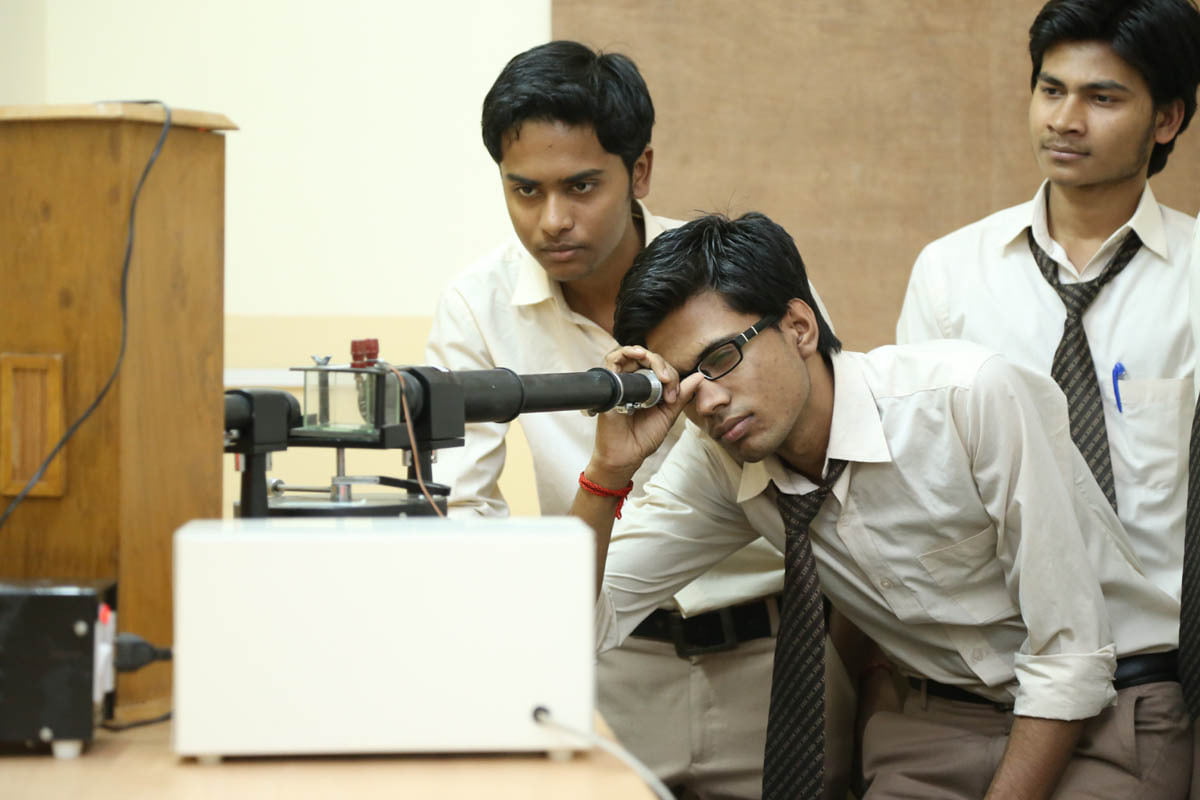
Physics Lab
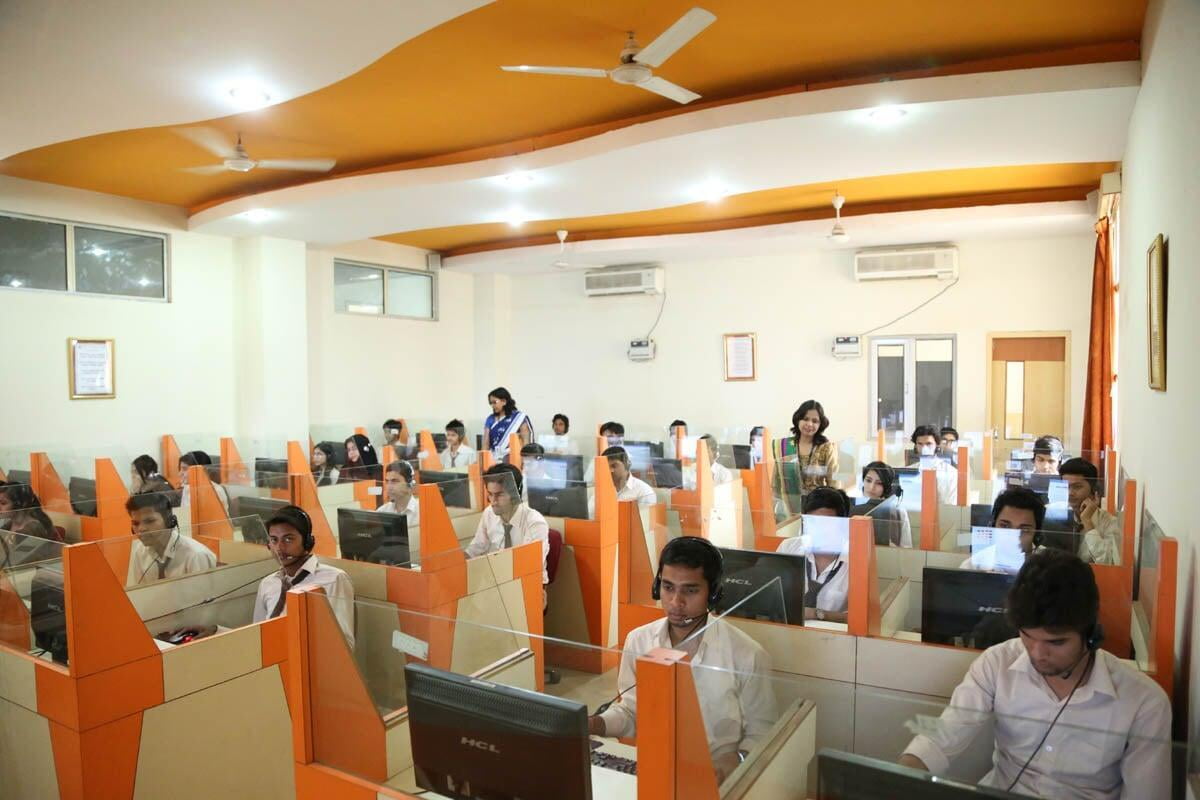
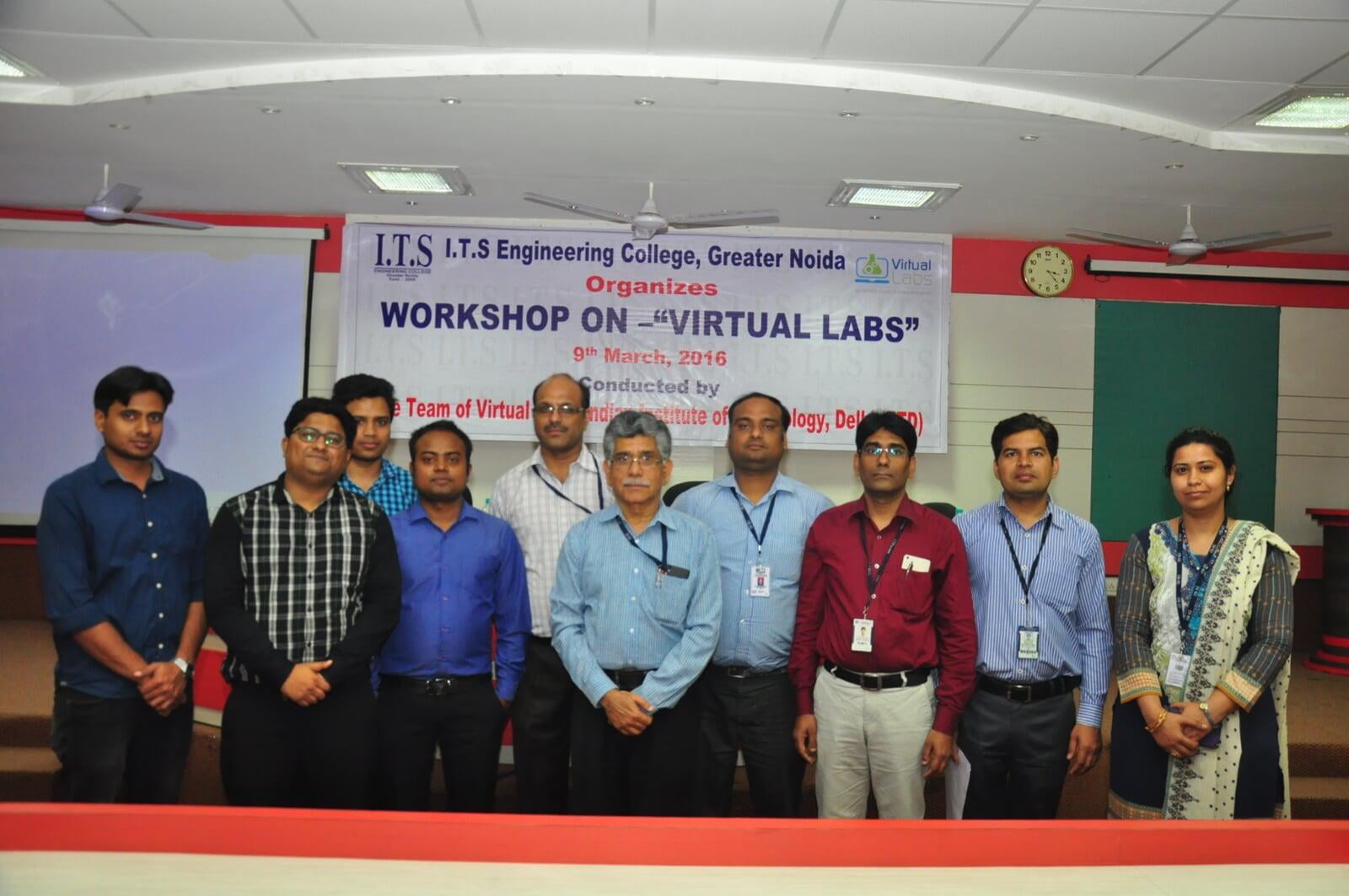
Virtual Lab
ITS Engineering College is a Nodal Centre of Virtual Lab IIT Delhi.
It is an Initiative of Ministry of Human Resource Development (MHRD) under the National Mission on Education through ICT.
The objective of virtual lab is to provide remote-access to Labs in various disciplines of Science and Engineering
More information here - http://www.vlab.co.in/




